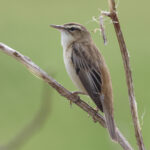Day 1 of a three day long weekend of Winter & Owl Tours today. It was a very frosty start but it turned into a beautiful winter’s day, with clear skies and sunshine. A great day for winter birding.
Leaving Wells, we headed inland. We were looking for owls first thing this morning, but with the combination of a frost on the ground and some warming early sunshine, we thought it might be worth a quick look around New Holkham. There has been a Great Grey Shrike here for the last couple of weeks, but it is obviously wandering over a huge area as it has only been seen on two days in all that time! As we drove along, the first birds we saw were two Red Kites perched in a tree in the sunshine. A little further along, we found a Common Buzzard standing on the top of a hedge. The raptors were out warming themselves in the sun, at least. But the shrike had not read the script and there was no sign of it in a very quick look round.
Continuing on, we came across a nice selection of farmland wildlife. There were several Brown Hares in the fields and two chasing after each other suggested that a mad March may not be far off. A couple of round lumps in a winter wheat field turned out to be a pair of Grey Partridge fluffed up against the cold – we could see the male’s black belly patch and orange face, as he watched the female feeding. A Pheasant‘s bright plumage glowed in the sunshine.
We checked out a couple of owl sites on the way, but there was no sign of any Barn Owls or Little Owls at first. However, at the third place we stopped we immediately found ourselves watching a rather distant Little Owl. Scanning the other farm buildings periodically, a second appeared and eventually a third Little Owl, the latter much closer. It was also more active, presumably having just come out of its roost to enjoy the warming rays. It stood preening for a while, before flying up and down the roof.
 Little Owl – we eventually found three enjoying the morning sun
Little Owl – we eventually found three enjoying the morning sun
There were lots of other birds to see here too. A smart male Yellowhammer flew up and landed on a tree in front of us. A large flock of Lapwing flew up from a stubble field, along with several Curlews. A small flock of Golden Plover flew overhead calling plaintively. Three Stock Doves took off from one of the barns and circled round. A small skein of Pink-footed Geese flew past and several flocks of Brent Geese came up from the direction of the coast and disappeared off inland, looking for a field of winter wheat to feed on. Another Red Kite flapped lazily across in front of the trees in the distance. It was a typical Norfolk winter farm scene, even including the banging gunfire in the distance from the local Pheasant shoot!
 Brent Geese – heading inland from the coast to feed on the fields
Brent Geese – heading inland from the coast to feed on the fields
Our next stop of the day was Sheringham. Even as we made our way down to the prom, we could see a large pale gull on the sea in front of us. A quick look through binoculars confirmed it was a cracking adult Glaucous Gull. There has been a small invasion of these arctic ‘white-winged’ gulls in the last few weeks, and several of them have been feeding along the beach here. We watched it swim across and climb out onto one of the wooden groynes, where we had a great view of it through the scope.
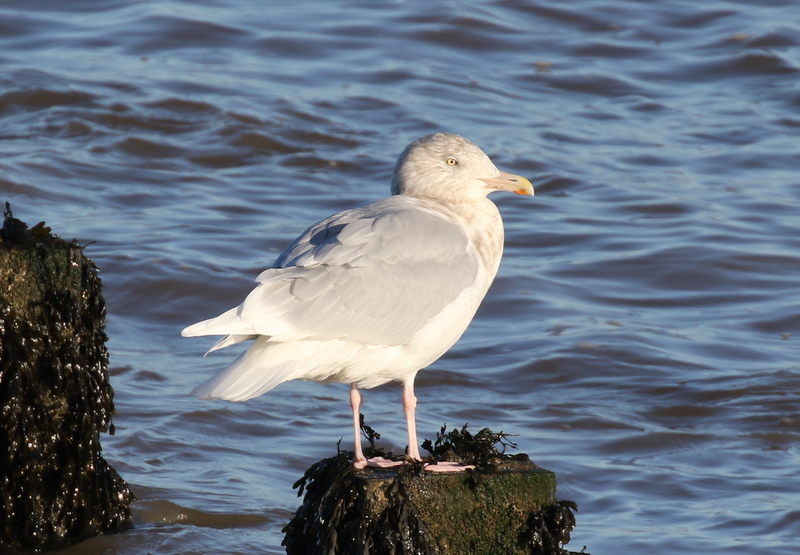 Glaucous Gull – a very smart adult with white wing tips
Glaucous Gull – a very smart adult with white wing tips
Looking across to the next groyne along, we could see another large and rather pallid gull, but this one was a juvenile Glaucous Gull. The adult dropped down to the sea and swam across, before chasing the juvenile off its perch. As the juvenile flew past us, we could see its pale wingtips, not white like the adult’s but still about the palest part of it’s plumage. The Glaucous Gulls have been feeding on the remains of a dead seal, washed up onto the beach after last week’s storms, but there was no sign of it today. Either the sea washed it away overnight or it has been ‘tidied’ up.
The juvenile Glaucous Gull landed again on another groyne, a short way back along the prom. We walked back for a closer look. Through the scope we could see its distinctive bill – large, with a bright pink base and squared off black tip looking like it had been dipped in ink. Helpfully, there was a nice selection of gulls on the posts here. The Glaucous Gull was about as big as the Great Black-backed Gull next door, and they both dwarfed a Herring Gull on the next post.
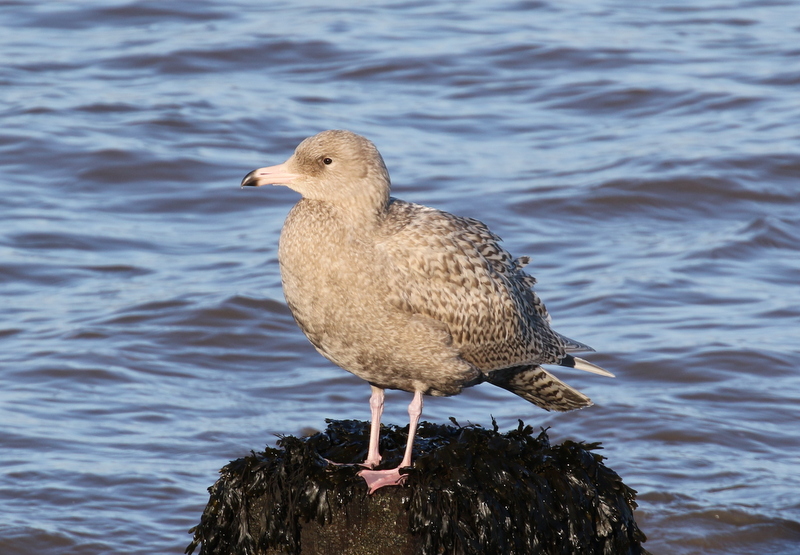 Glaucous Gull – a juvenile with a ‘dipped in ink’ bill tip
Glaucous Gull – a juvenile with a ‘dipped in ink’ bill tip
Having enjoyed fantastic views of the two Glaucous Gulls, we set off along the prom towards the east end. There were lots of Turnstones, and a little group were feeding on the grassy bank right beside the path as we passed. Scanning the rocky sea defenses further along, we found the Purple Sandpiper which is spending the winter here. Its upperparts looked sort of purple-toned through the scope, and we could see its orange bill base and legs. It was picking around on the seaweed and algae covered rocks on the edge of the sea.
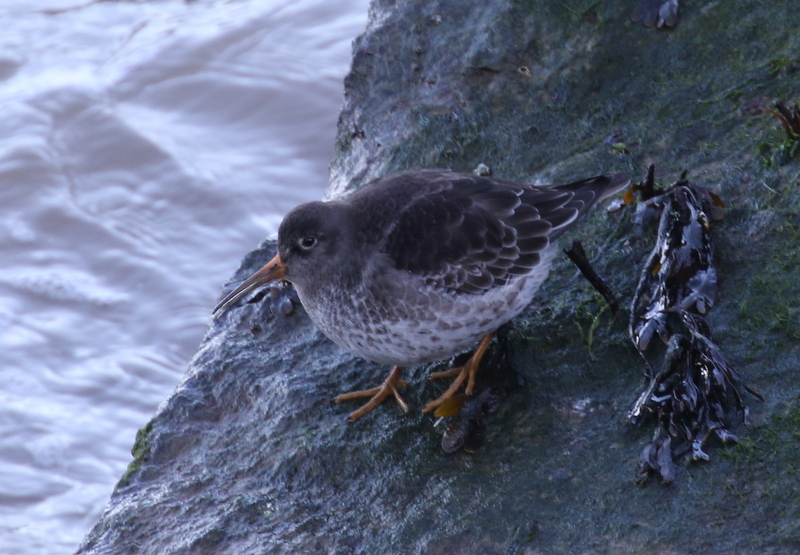 Purple Sandpiper – on the rocky sea defenses at Sheringham
Purple Sandpiper – on the rocky sea defenses at Sheringham
Looking out to sea, we could see a steady passage of Red-throated Divers, all heading east in little groups of two or three. A few Guillemots flew past too, and we also managed to find a couple on the sea. One was a regular pale-faced winter plumage individual but one of the Guillemots was already in summer plumage, with a blackish-brown head.
Making our way back west along the coast road, we could see a huge throng of geese in a recently harvested sugar beet field, so we stopped for a closer look. They were mostly Pink-footed Geese, which have been coming in here over the last few days to feed on the beet tops left behind after the beet itself has been harvested. Thankfully, another local birder was there and quickly got us on to two of the Tundra Bean Geese which have been with them. Through the scope, they were easiest to pick out from the Pink-footed Geese by their bright orange legs but we could also see the heavier bill with orange band on the Tundra Bean Geese.
At that point, the geese in one corner of the field started to fly up. Most of them landed again further over, and we were just getting everyone on to a couple of White-fronted Geese when the whole field erupted. There were thousands of geese circling nervously overhead calling. It was quite a sight to watch and listen to all the geese flying round. We looked across to see a farm worker in a tractor driving round the edge of the field. After he had driven round two sides and back again, and then round in front of us and down the fourth side for good measure, we started to think he had probably just flushed the geese for the sake of it!
 Pink-footed Geese – around 5,000 were in fields at Weybourne today
Pink-footed Geese – around 5,000 were in fields at Weybourne today
Eventually all the geese started to fly off west and we decided to join them. It was fortunate there was someone to show us where the Tundra Bean Geese were, as there were apparently only 8-9 in with 5,000 Pinkfeet and we would not have had time to search through the flock on our own before they were flushed.
Our next stop was at Kelling. The floods along the coast after last weekend’s storm surge have largely receded now, but they have left behind large amounts of debris, particularly reed litter washed out from the bottom of the reedbeds at Cley and Salthouse. With large quantities of seed mixed in with it, this debris has been a bonus for seed eating birds. The flock of Snow Buntings which had been feeding on the shingle ridge before the storm surge have now taken to feeding on the tide line where all this debris has been deposited.
We were warned as we walked down along the track past the Water Meadow that the Snow Buntings had earlier been pushed further and further along the lane by people watching them, and it was perhaps no surprise that we couldn’t find them at first. We did find a pair of Stonechats feeding along the tideline, accompanied by a Chiffchaff which had probably been forced out of the reedbed by the floods. There were also a couple of Reed Buntings and a few Meadow Pipits.
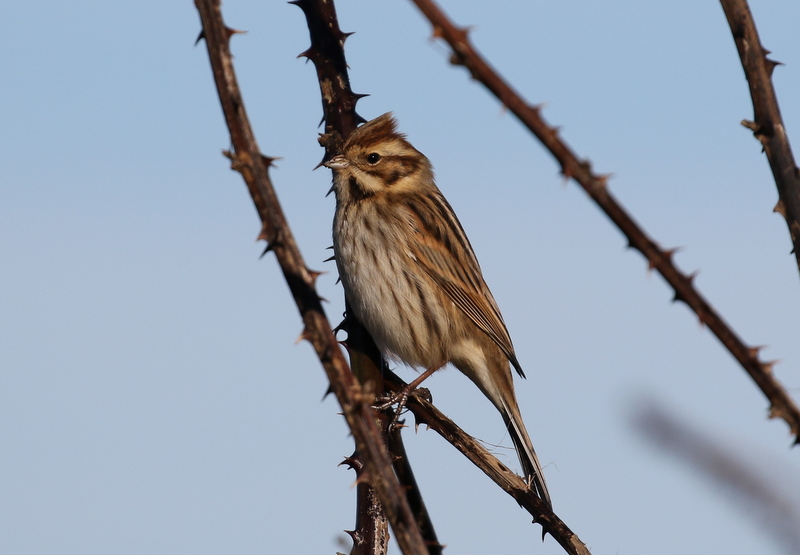 Reed Bunting – a couple were feeding on the reed debris left behind by the flood
Reed Bunting – a couple were feeding on the reed debris left behind by the flood
Looking over towards the shingle ridge, we could see a small group of birders gathered and then a small group of Snow Buntings flew up from the ground near to them. The birds had obviously gone over to that side when they had been flushed. There was no sign of them coming back, so we set off to walk round there. Needless to say, we got half way round to be told that they had just flown back again! Thankfully, when we returned there the Snow Buntings were now feeding happily on the debris again and we had a great look at them. They may have given us the runaround, but we got there in the end!
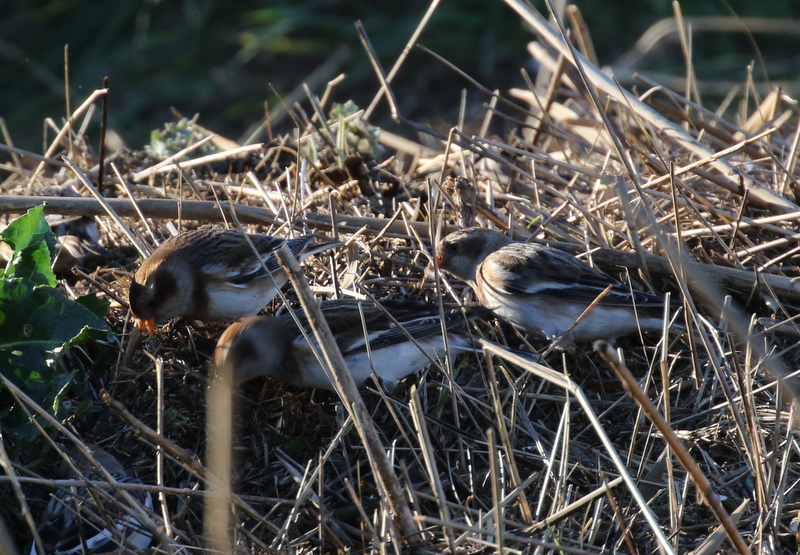 Snow Buntings – feeding on the reed debris left behind by the floods
Snow Buntings – feeding on the reed debris left behind by the floods
There were at least 40 Snow Buntings here, though they were hard to count as they rooted in and out of the piles of dead reeds. Periodically, they would fly round in a little whirl, white wings flashing, before landing back down to feed.
With our mission finally accomplished, we set off back to the car and made our way along the coast towards Cley for a later than planned lunch. We had to make one more unscheduled stop on the way though, as a Barn Owl appeared over the field behind Walsey Hills. It flew towards us and then crossed the road, going right past us over the verge the other side. A stunning view!
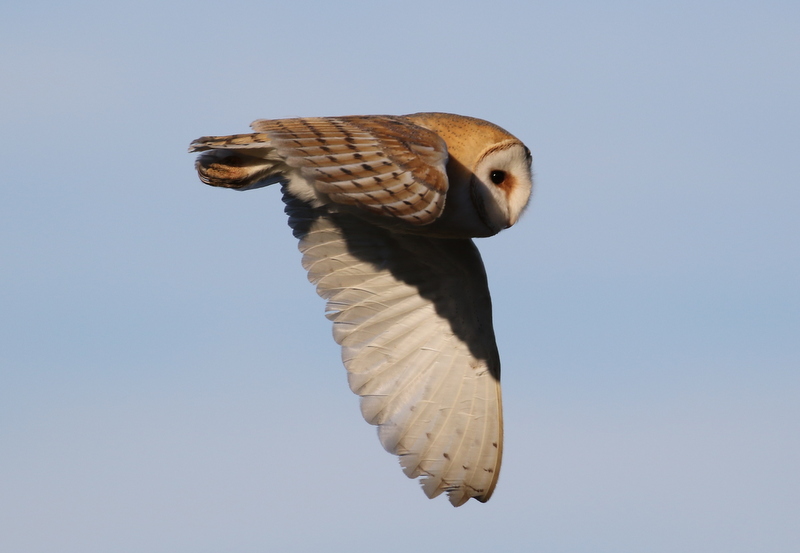 Barn Owl – flew past us along the coast road at Cley
Barn Owl – flew past us along the coast road at Cley
The reserve at Cley is closed after the floods, but after lunch we had a quick scan of the scrapes from the Visitor Centre. There was no sign of the Smew which had been seen here this morning but we did see a couple of pairs of Pintail, the drakes looking very smart now with their long pin-shaped tails. A couple of Marsh Harriers quartered over the reedbed.
We headed out along the East Bank next. There were lots of Golden Plover out on the grass, now the flood waters have receded. In amongst them, were good numbers of diminutive grey and white Dunlin. A couple of Common Snipe flew down along the grassy edge just beyond the channel and landed next to a Lapwing right in front of us, giving us great views of them through the scope. Further over, we found a couple of Black-tailed Godwit and a lone Ruff. A Grey Plover feeding on the grass had possibly been forced over from Arnolds Marsh, which is still flooded.
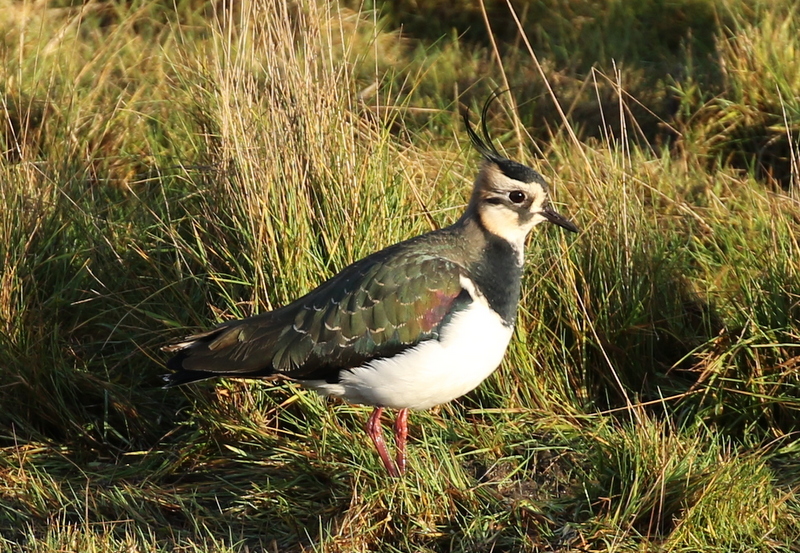 Lapwing – on the grazing marsh below the East Bank at Cley
Lapwing – on the grazing marsh below the East Bank at Cley
There was a nice selection of ducks out here too. There were several more Pintail and again we stopped to admire a couple of very smart drakes. We also found a couple of Gadwall and a few Shoveler which were new for the day. Some Brent Geese were feeding nervously out on the grass but got spooked by something and flew off calling. A lone Little Grebe was diving out on the water at the back. A Little Egret looked stunning in the late afternoon sun down in front of us, trying to stir up the mud below the water with its feet, hoping to disturb something tasty to eat.
 Little Egret – feeding on the pools off the East Bank
Little Egret – feeding on the pools off the East Bank
Scanning the edges of the marshes carefully, we came across a large pale gull sitting down on a muddy bank. On closer inspection, it was another juvenile Glaucous Gull, our third Glaucous Gull of the day. As we walked further along the bank, it finally woke up and had a fly round over the water.
We had a quick look out to sea from the end of the East Bank. As at Sheringham earlier, there were several Red-throated Divers still moving past, but this time we also managed to find a couple of them on the sea. There were also a few more Guillemots. A distant Gannet flew past offshore. Then it was time to head back.
Turning off the coast road and heading inland, we hadn’t gone very far when we found another Barn Owl. It was hunting out over a grassy field, flying round and round. It dropped down into the grass and when it came up again it flew over onto a fence post nearby. It appeared to have caught something but by the time we got the scope onto the Barn Owl, whatever had been caught had already been eaten.
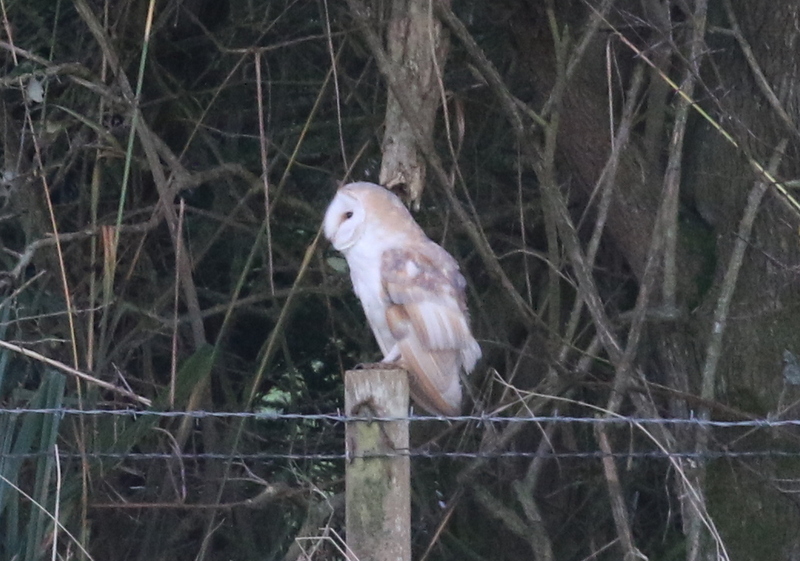 Barn Owl – our second of the day, taking a break from hunting
Barn Owl – our second of the day, taking a break from hunting
Then the Barn Owl was off again, doing a quick circuit of the back of the field, before flying over the hedge at the back. We caught up with it briefly as it flew across the field next door and then it was off again back and out of view. As we turned to walk back to the car, a small flock of about 40 geese flew overhead. We could just see the distinctive black belly bars of White-fronted Geese before the flew off away from us.
It was almost time to look for Tawny Owls, so we made our way over to where we hoped to see them. It was such a bright evening that we had enough time for a quick look at some wet meadows nearby and were rewarded with another two Barn Owls out hunting. We could hear a Song Thrush singing in the trees behind us, the first we have heard this year. Perhaps it knows something we don’t, that spring is not far away? Then it was time to get into position.
It was a slow start this evening. The Tawny Owls were not hooting much again and were rather late to emerge from the roost tonight. A muffled hoot did alert us to the fact that the nearest male had moved roost tree tonight, but then he went silent. It looked like we might be out of luck, but then a large dark shape flew towards us through the trees on big, rounded wings. Even better, it perched up in a tree in front of us. We all had a great view of it through binoculars as it perched looking at us for a few seconds. Then it was off again through the trees.
We followed after the Tawny Owl, but without him hooting he would be hard to locate. A quick whistle from us and we were rewarded with a hoot in reply. Another whistle, and we thought we might be able to work out where he was perched, but instead a dark shape whistled past us only a few metres away and low over the ground – he had flown past to check us out! Unfortunately, it was getting dark now and with him so low through the trees he was all but impossible to see, but then he started hooting again behind us. It was time to leave him in peace, but what a great way to end a day of winter birds and owls!




